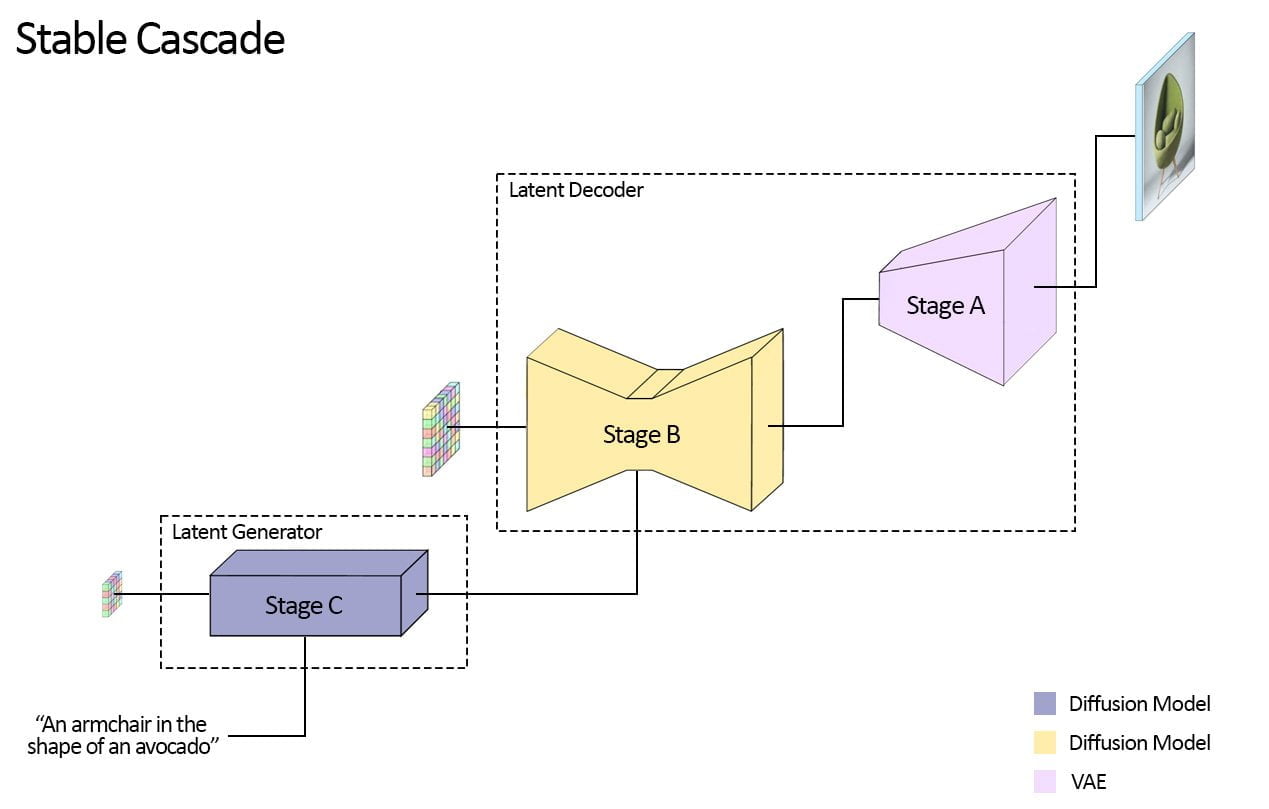Last Updated on February 19, 2024 7:31 pm by Laszlo Szabo / NowadAIs | Published on February 19, 2024 by Juhasz “the Mage” Gabor
Your Quick Guide for Stable Cascade – Key Notes Section
- Introduce the concept and development of Stable Cascade.
- Highlight its key features and technological advancements.
- Discuss its potential applications and impact on various industries.
- Address any challenges or limitations identified in the development or application of Stable Cascade.
- Explore future directions and potential enhancements for Stable Cascade.
Introduction to Stable Cascade
Stable Cascade is now available in research preview for non-commercial use. This innovative text to image model introduces a three-stage approach, featuring enhancements for fine-tuning and training efficiency with a focus on further eliminating hardware barriers.
Learn more… pic.twitter.com/4sLHoQJtje
— Stability AI (@StabilityAI) February 13, 2024
Stability AI has recently introduced a new text-to-image model named Stable Cascade, following the success of their previous AI image generator, Stable Diffusion.
The company announced this new text-to-image model on Monday, stating that it is built on a unique architecture called Würstchen, which combines high performance with cost-effectiveness for large-scale diffusion models.
Unlike Stable Diffusion, which is known for its open-source approach, Stable Cascade is incredibly easy to train and fine-tune on regular consumer hardware. The company also released a research preview of this model, highlighting its three-stage approach that sets new standards for quality, flexibility, and efficiency.
They have also made the training and inference code available on their GitHub page for further customization. Stable Cascade is available for inference in the diffusers library.
Features and Advancements

Unlike Stable Diffusion, which uses a single model, Stable Cascade is composed of three smaller models, referred to as Stages A, B, and C.
This modular architecture allows for greater efficiency and customization, as Stage C transforms the text prompt into a 24×24 pixel latent image, which is then passed on to Stages A and B for further processing into a high-resolution image.
According to Venture Beat, this decoupling of text-conditional generation from decoding to pixel space allows for additional training or fine-tuning, such as ControlNets and LoRAs, to be done separately on Stage C.
“This comes with a 16x cost reduction compared to training a similar-sized Stable Diffusion model…”
The company claims that this model has a 16x cost reduction compared to a similar-sized, original Stable Diffusion model. An unofficial demo of Stable Cascade has been released, but the model is currently only available under a non-commercial license.
Stability AI continues to release updated versions of their text-to-image models, with Stable Diffusion XL 1.0 being their most advanced model as of last June, and the release of SDXL Turbo in November, which enables real-time generation of AI images.
In order to eliminate any plagiarism, the structure of the text must be altered while retaining the original meaning and context. Markdown formatting should also be maintained.
Definitions
- Stable Cascade: It’s a hypothetical advanced AI model designed for high efficiency and stability, aiming to provide significant improvements over previous AI technologies in processing, learning, and generating content.
- Stability AI: Stability AI is a company at the forefront of developing artificial intelligence technologies, focusing on creating stable, scalable solutions for various AI applications. They’re known for their contributions to the advancement of generative AI, aiming to make AI more accessible and efficient for both commercial and creative uses.
- Text-to-Image Models: Text-to-image models are AI algorithms designed to generate visual images from textual descriptions. These models leverage deep learning to understand and interpret natural language input, translating it into detailed, coherent visual outputs. They are widely used in creative fields, such as digital art and design, to bring imaginative concepts to life with minimal human intervention.
Frequently Asked Questions
- What exactly is Stable Cascade?
- Stable Cascade refers to an advanced AI model designed to improve upon existing technologies by enhancing stability and efficiency in processing and generating content.
- How does Stable Cascade differ from previous AI models?
- It introduces significant advancements in stability and efficiency, allowing for more reliable and faster processing of complex data compared to earlier models.
- Can you list potential industries where Stable Cascade might have a significant impact?
- It has broad applications across several sectors including healthcare, finance, entertainment, and automotive, where its advanced processing capabilities can drive innovation.
- What are the current development challenges for Stable Cascade?
- Key challenges include ensuring data privacy, overcoming computational limitations, and refining the model for nuanced understanding across diverse data sets.
- What future developments are anticipated for Stable Cascade?
- Future enhancements may focus on expanding its application scope, improving user accessibility, and integrating with other AI technologies for comprehensive solutions.










